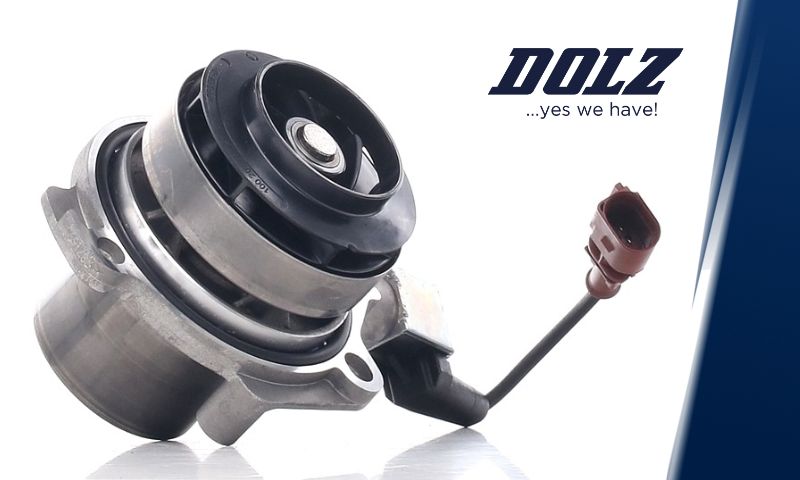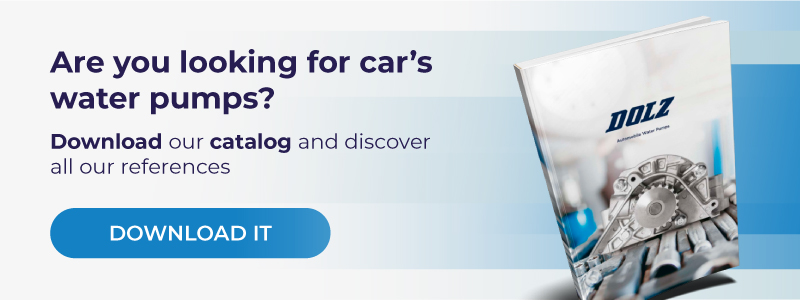In this article, we will look at how a solenoid is designed, its function, and how it is used in the A255V water pump. Addressing the most frequently asked questions by mechanics and professionals in the sector relating to this device.
This popular water pump, suitable for the VAG group, applies to a wide range of applications. More than 14.5 million vehicles are in circulation throughout European roads with this reference. 
One of the most popular applications that we find is the Volkswagen Golf D 1.6, 77kW that has been manufactured since 2012 until the present. With engine code CLHA, there are more than 142,000 registered vehicles.
What is the A255V Water Pump Solenoid?
If we look at the water pump, we see that it has an electric switch. But what is this connector? Is it a sensor? What is it for? 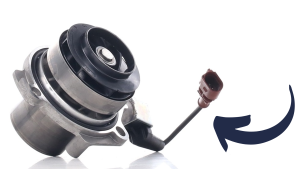
Many mechanics have doubts, some of them think that this cable is a temperature sensor, but this is not like this. It is a solenoid, or which is the same, an electromagnetic device that features electromagnetic linear actuation when subjected to an electric current.
To start with the basics, let’s review the vital components of a solenoid, which are a conductive, a coil of wire and ferromagnetic cylinder.
When electric current in the solenoid flows through the coil, a magnetic force is produced, and the plunger moves to the left.
Conversely, if no electricity flows through the coil, the plunger simply stays closed.

How does a solenoid work?
As seen in Figure 1 we see that when no electricity flows through the solenoid, the ball remains intact, keeping the circuit open (blue color) and allowing the coolant liquid through the conduit. On the contrary, in Figure 2 we can see that when electricity passes through the solenoid, the plunger pushes the ball to the left, closing the internal coolant circuit (red color).
Here is a more visual example of both situations:
- NO electricity by the solenoid.
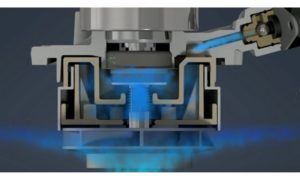
The coolant circuit remains open because the solenoid does not block the circuit, giving the maximum flow depending on the engine speed.
- If current flows through the solenoid.
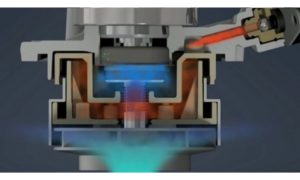
The magnetic field induces a force that pushes the ball, closes the internal coolant circuit and then generates a pressure and the shield will extend to cover the impeller. Which will result in the blockage in the coolant outlet of the water pump.
All this will make it easier for the engine to reach its optimal operating temperature faster.
What conclusions can we draw?
1.- The solenoid is not a sensor, in simple words, the solenoid is a device that converts electrical energy into mechanical work.
2.- If we connect the solenoid to a mechanical pump (not variable/switchable) it will not give any error in the control unit. If the electronic control unit gives an error from the water pump, it is because the solenoid is damaged, and it will have to be replaced.
3.- When replacing the water pump, if the existing solenoid works properly, we can use it to place it in the new water pump.
How to install solenoid in the water pump?
On the other hand, there are mechanical versions of this water pump without the impeller shield. What happens if we connect the solenoid to these pumps? Should we connect it or not?
Mechanically there is no problem. You can connect the solenoid without any issues, this won’t function. The mechanical pump will have the same maximum performance as a switchable design. However, we always recommend connecting the solenoid to the mechanical water pump to ensure the device doesn’t move around the engine and can be damaged.
To correctly install the solenoid, we first proceed to unscrew it and remove it from the old water pump. Then, as recommended by Industrias Dolz, it is screwed into the new one, regardless of whether the version is, variable or mechanical.
For further information on any of our product lines, receive commercial information or technical product specifications (including assembly notes), CLICK HERE.

